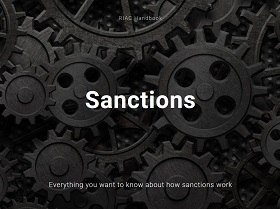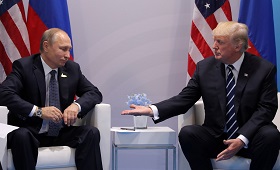The US sanctions bill (PL 115-44) offers a clear idea of the parameters and dimensions of the US sanctions policy for 2018. Approved by Congress on August 2, 2017, the Act outlines specific forms of executive reporting on the course and trends in implementing the sanctions. This makes it possible to forecast events in 2018 that will largely reflect the basic parameters of restrictive pressure on Russia.
It must be clear that the letter and spirit of PL 115-44 define Russia in legislative terms as an adversary to the United States, which should be actively opposed and subjected to a comprehensive pressure. In fact, PL 115-44 sets the framework for US policies with regard to the Russian Federation, which to a great extent obviates opportunities for partnership and constructive cooperation. Russia should have no illusions about a reversal of course in the near future. We must also avoid underestimating the efficiency of the tools to pressure us. These trends need to be thoroughly analyzed and monitored.
So, the executive authorities will submit at least seven reports to Congress in 2018, which can be divided into three groups.
The first group includes reports drawn up mostly by the US Department of the Treasury. The U.S. Treasury is the key, if not the only, sanctions policy tool. Congress instructs the U.S. Treasury to work closely with the CIA, the Department of State and other agencies whose data may significantly expand capabilities of financial intelligence. The most expected document in this group is a report on Russian oligarchs and parastatal entities to be prepared by February 2018 and which contains a list of senior Russian political figures as well as oligarchs and entrepreneurs close to the “Russian regime.” Congress wants the submission of an assessment of the relationship between the said individuals and President Vladimir Putin or other members of the Russian ruling elite and an identification of any indices of corruption with respect to those individuals. The report should also include the estimated net worth and known sources of income of those individuals and their family members, including assets, investments, other business interests, and relevant beneficial ownership information and an identification of the non-Russian business affiliation of those individuals.
But being included in the report does not automatically mean that individuals or entities will face sanctions. Nevertheless, the Act unambiguously indicates that the report is a mechanism for their expansion. At least it is required to assess the potential impacts of imposing secondary sanctions with respect to Russian oligarchs, Russian state-owned enterprises, and Russian parastatal entities, including impacts on the entities themselves and on the economy of the Russian Federation, as well as on the economies of the United States and allies of the United States.
In theory, the report may include an unlimited number of Russian individuals and entities. But the algorithm and methodology of its compilation within so brief a timeframe is still a big question. It requires processing a huge amount of information, since, in fact, the case in point is Russia’s entire public sector. This significantly increases the risk of erroneous assessments, which may later affect the United States itself. In theory, the Americans may also choose to present a compact report that will include what they think are the most anti-Western figures. But one nicety involved is that the Act’s current wording does not imply that the report should be constantly updated and therefore the anti-Russia lobby can do what it will to expand the lists as much as possible.
The next report is to appear in February as well. It concerns opportunities for expanding sanctions against individuals or entities blacklisted by the Department of the Treasury under Presidential Executive Order No. 13662, which made it possible to impose sanctions to counteract Russian policies in Ukraine. The fine point is that the executive order imposed sanctions against Russia’s financial and energy sectors, while PL 115-44 added railways to the list, as well as the iron-and-steel and manufacturing industries. For the time being, the report is not to be expanded.
Unlike the previous two, the next report will require a longer preparatory period – until August 2018 – and is to be updated annually until 2021 (but there is nothing to prevent the timeframe from being extended). The report will concern any illicit financial transactions related to the Russian Federation or Russian nationals. It will contain data on specific violations, results of investigative actions, and outreach to the private sector to prevent these kinds of activities. Inclusion in the report involves criminal prosecution.
Importantly, it should disclose the outcome of US agencies’ cooperation with their counterparts in the EU and other countries. In other words, it internationalizes US practices. The report is also a mechanism for finding loopholes in law enforcement with regard to anti-Russia sanctions and has to include trouble-shooting proposals.
The next group is covered by the subtitle, Countering Russian Influence in Europe and Eurasia. The Act makes it incumbent on the US government to act as a protector of the sovereignty and security of all Eurasian countries that are or may become “victims” of Russian influence. The Department of State is the key agency responsible for this group. Policies in this area imply the broad use of soft power based on NGOs in the US and Eurasian countries (the Act lists some of these). The appropriations for these purposes in 2018 will add up to $250,000,000, a considerable sum given that it will be largely used for ideological and educational work rather than for infrastructure. At first glance, the money is spread across a wide spectrum of objectives and countries, such as protection of electoral infrastructure, the fight against corruption, legislative improvements, aid to NGOs and the media, and opposition to “propaganda.” However, given the low cost of these measures and their focus on countering Russia, they will become a serious source of pressure. At least this sum is much greater than Russia’s own “soft power” expenses. What’s more, Russian institutions are addressing the entire international agenda, while the West (let alone opposition to it) is not the first, nor the only target of its efforts.
PL 115-04 makes it incumbent on the State Department to report to Congress annually, including its performance, spending efficiency, and results. A separate report will cover cooperation with foreign entities and their contribution. In other words, the Americans expect that their spending should be reinforced by that of their allies in the EU and other countries. The report is due to be submitted on April 1.
The next two reports also need to be submitted annually by the US President.
The first is on the media organizations controlled and funded by the government of the Russian Federation. It is also a black list of sorts involving at least reputation effects and due to stigmatize both Russian media proper and those supported by Russia in some or other form.
The other concerns Russian Federation influence on elections in Europe and Eurasia. This is important as a tool for internationalizing the American approach to supposed Russian “electoral interference.” Unlike the United States, people in Europe and elsewhere are more or less skeptical of the US position. The annual report will make it possible to perpetuate the focus on this subject by aggregating events of any importance and prodding the related Western discourse towards the US stance.
Finally, yet another report is linked to a law on Ukrainian and other countries’ energy security interpreted as reduced reliance on Russian distribution or any ties with Russia. It is speaking about facilitation of Ukrainian energy sector reforms, the sector’s liberalization, enhanced efficiency, etc. But in the same breath it mentions counteraction to Russian energy projects (Nord Stream, etc.) and what it calls “Russian aggression.” It also says directly that the US policy should be aimed at promoting US energy exports to Europe, among other things, to create jobs in the United States. (This means that the Americans are using this political tool in market rivalry.) The Secretary of State is to report on the implementation of the Ukraine Freedom Support Act and on achievements in this area in February, with subsequent updates to be submitted every six months.
The bottom line is that PL 115-04 prescribes a specific bureaucratic procedure and narrative that will largely define US policy with regard to Russia in 2018 and thereafter. There will be at least seven reports submitted next year, each of which will most likely provide a pretext for the further alienation of Russia and the United States from each other. Russia needs a well-considered policy of clever actions that will make it possible to control confrontation, minimize damage, and retain foreign policy initiative.
Author: Ivan Timofeev is Programme Director of the Valdai Discussion Club, Director of Programs at Russian International Affairs Council (RIAC).
First published in Valdai Discussion Club







